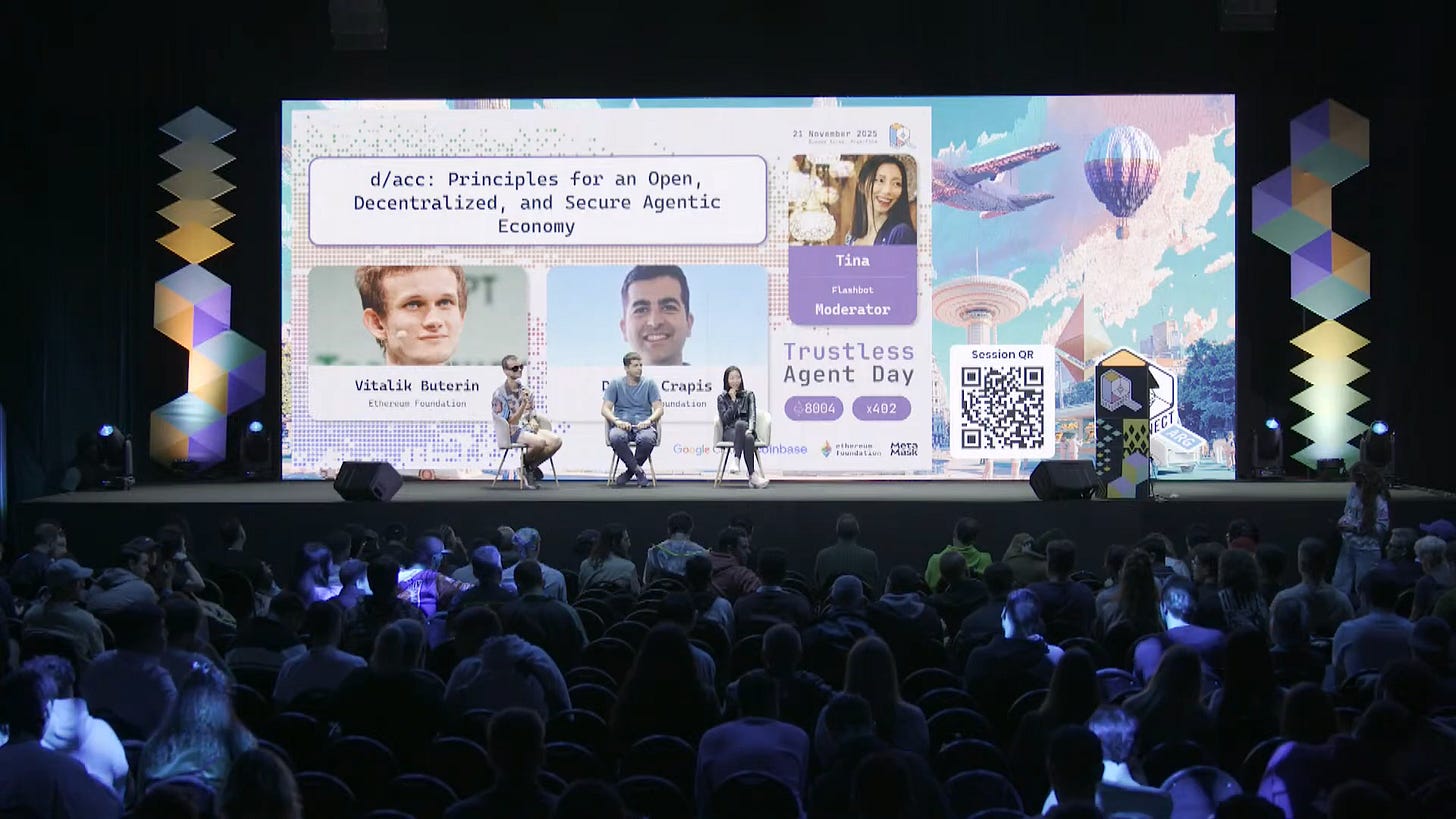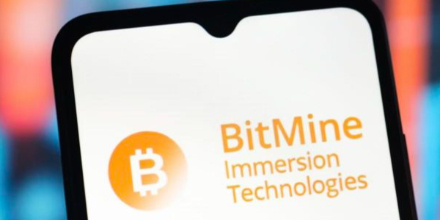Vitalik discusses AI Agent: Building trust with ERC-8004, suggests application directions such as real-time translation
Devconnect Trustless Agent Day Final Panel In-Depth Review: Vitalik and EF dAI Lead Explain x402, Privacy, and the Future of Computing.
Devconnect Trustless Agent Day Grand Finale Panel In-depth Review: Vitalik and EF dAI Lead Explain x402, Privacy, and the Future of Computing.
Written by: ZHIXIONG PAN
During Ethereum Devconnect, an event called Trustless Agent Day brought together the leading thinkers at the intersection of Web3 and AI. This grand finale panel was hosted by Tina from Flashbots, with core guests Ethereum co-founder Vitalik Buterin and Ethereum Foundation dAI team lead Davide Crapis.
This conversation was not only about technical standards, but also a projection of the architecture of future digital society: When AI agents become the main participants in economic activities, what kind of infrastructure, trust models, and privacy protections do we need?
The Twin Pillars of Infrastructure: Payments and Discovery (x402 and ERC-8004)
The starting point of the conversation was built on two core protocols: x402 for payments and ERC-8004 for service discovery, which together form the cornerstone of the agent economy.
Vitalik’s Vision for Reconstructing Micropayments
Vitalik first expressed his excitement about micropayments in the AI era. He believes that the involvement of AI makes micropayments truly feasible. In the human world, deciding “whether to pay 4 cents or 11 cents for a service” is not only time-consuming but also mentally burdensome, but for AI agents, this is a millisecond-level computational decision.
Vitalik emphasized that “pay for what you consume” is the most efficient economic model. But he also pointed out that such high-frequency payments must be built on privacy protection. Without protection, an agent’s thousands of query records would completely expose a user’s behavioral patterns. Therefore, integrating ZK (zero-knowledge proof) technology is crucial. For example, a user can prepay a sum (like $5) in exchange for 5,000 query credentials, and on-chain, these 5,000 queries are unlinkable to each other.
Davide and ERC-8004: From Payments to Trust
If x402 solves the “how to pay” problem, Davide’s ERC-8004 attempts to solve the “who to pay” problem. Davide said that when he saw people start making micropayments to web services or AI via x402, a fundamental question emerged: how do you trust these services?
ERC-8004 (Trustless Agent Standard) was thus born. It is not a simple whitelist, but a decentralized service discovery mechanism. It allows service providers to register and showcase their capabilities on-chain. Davide divides trust into two categories:
- Soft Trust: Based on past performance, reputation accumulation, and audit results.
- Hard Trust: Based on cryptographic proofs or crypto-economic guarantees.
The ERC-8004 standardizes the interaction format of this information, enabling agents to autonomously find and verify service providers in a decentralized network.
The Elephant in the Room: The Gap Between Ideal and Reality
Before discussing the future, moderator Tina handed the microphone to the audience, launching a discussion to “find the elephant in the room”—those obvious but overlooked industry pain points.
The “Role-Playing” Crisis of Agents
Developer Shaw raised a sharp point: we don’t yet have truly usable agents. He pointed out that most current agents are trained on text data from Reddit and similar sources; they know the “theoretical steps of baking a cake,” but have never actually “baked a cake” in the real world. Today’s agents try to trade and predict markets, which is an “out of distribution” operation. To some extent, the industry is engaged in an expensive LARP (live-action role-playing), lacking agents with true end-to-end execution capabilities.
The Double Blow of Cost and Bias
Another developer, Tim, pointed out the unsustainability of the economics: inference costs are too high. Every tiny decision call burns funding. To realize the x402 vision, the cost per decision must drop below 10% of the transaction fee. Currently, many startups are surviving only on the free quotas provided by cloud service providers.
Additionally, Andrew Miller poured cold water on reputation systems, arguing that history shows reputation systems often favor incumbents and are prone to failure. He suggested the only solution might be to use TEE (Trusted Execution Environment) sandboxes, allowing open-source agents to enter the sandbox to evaluate the security of closed-source agents.
Why Blockchain? The Native Habitat of Agents
Given so many problems, why do we insist on building the agent economy on blockchain? Vitalik and Davide gave answers that go beyond “payment tools.”
On-chain Games and Synthetic Assets
Vitalik offered an interesting perspective: blockchain is the natural soil for on-chain games, where “games” refer to market interactions in the game theory sense.
He believes agents do not need to establish trust through identity verification like humans; they are more suited to compete in an anonymous, trustless environment. More importantly, agents can understand and handle extremely complex synthetic assets—financial products composed of baskets of goods that are hard for humans to intuitively grasp but make logical sense to machines. This could give rise to agent-exclusive markets completely different from human financial markets.
Constrained Delegation
Davide added from a security perspective that blockchain provides “hard rules.” As humans delegate more and more decision-making power to AI (i.e., agentification), we need a safety catch. Smart contracts can implement constrained delegation. For example, I allow my DeFi agent to move funds for arbitrage, but the underlying smart contract code hardcodes “prohibit withdrawals” to external addresses. This code-based constraint is a level of security that traditional Web2 APIs cannot provide.

Privacy as a “Hygiene Habit”
On the topic of privacy, Vitalik put forward a core assertion: privacy is not a feature, but a hygiene habit.
He emphasized that we should not see privacy as a new gimmick added to products, but as “no longer leaking data.”
User Privacy > Service Privacy
On the priority of privacy protection, Vitalik’s stance is clear: user privacy is far more important than service privacy. We do not want to live in a world where users are scored and tracked, but we need service providers (agents) to have publicly transparent reputation records. He even envisions using ZK technology to achieve “negative reputation proofs”—users can prove their interaction history (including records of negative reviews) without revealing specific identities, thus maintaining system honesty while protecting privacy.
How to Scale Privacy: TEE and Anonymization
Faced with the performance bottleneck of ZK in inference computing power, the discussion pointed to TEE (Trusted Execution Environment) as a pragmatic solution for now. Although it increases hardware costs, it is a bridge between reality and ideal. Vitalik added that besides hardware-level protection, anonymization is another underestimated direction. By using mix-nets to hide the source of requests, even if the content cannot be fully encrypted, users can still be largely protected from targeted analysis.
The Future of Computing: The Disappearance of Laptops?
Looking ahead to the infrastructure of the next 5 to 10 years, Vitalik made a highly futuristic prediction: laptops may disappear.
He believes that the current computing architecture has a fundamental economic contradiction: local-first is the most trustworthy, but extremely inefficient in terms of computing power utilization (personal demand is pulsed, and hardware is not only costly when idle but also needs charging).
The future trend is the decoupling of computing and user interface (UI). With the popularity of mobile phones, smart glasses, watches, and even brain-computer interfaces, the form of UI will become extremely fragmented, while the computing core may be separated from personal terminals.
This raises a huge unsolved problem: we need a new operating system or underlying architecture that allows users to safely use remote computing power while still maintaining a trust level equivalent to “local execution.”
From Protocol to Application
At the end of the conversation, Davide revealed that ERC-8004 will go live on the Ethereum mainnet in a few weeks. For him, the past few months have been “Season 1,” the stage where the community gathers and establishes standards; next comes “Season 2”: the improvement of infrastructure (such as browsers, SDKs) and the incubation of killer applications.
Vitalik gave a concrete suggestion: if you want to build a “trustless” product in the AI field, live translation is a perfect entry point. Current encrypted communication software protects transmission privacy, but translation functions often rely on centralized cloud services, which is the biggest gap in the privacy protection chain.
This panel was not only a technical evangelism for ERC-8004 and x402, but also a profound discussion on how, in an era of rapid AI development, cryptography and decentralized networks can help humanity retain a degree of sovereignty and privacy.
Disclaimer: The content of this article solely reflects the author's opinion and does not represent the platform in any capacity. This article is not intended to serve as a reference for making investment decisions.
You may also like
Bitcoin Holds the $84,000 Support Like a Champion: Oversold Rebound Targets $94,000 This Week
Bitcoin has successfully held the $84,000 support level and may rebound to $94,000 this week. If it falls below $80,000, it could further drop to $75,000. Although market sentiment is extremely bearish, a short-term oversold condition may trigger a rebound. Summary generated by Mars AI This summary was generated by the Mars AI model, and its accuracy and completeness are still being updated iteratively.

What will happen to the price of DOGE after the listing of Grayscale's GDOG ETF?
Dogecoin's price is being suppressed by resistance at $0.1495, with short-term support at $0.144. Grayscale's DOGE ETF debut failed to boost the price, and continued whale sell-offs are exerting further pressure. Technical analysis indicates a neutral-to-bearish trend, lacking clear reversal signals. Summary generated by Mars AI. This summary was generated by the Mars AI model, and the accuracy and completeness of its content are still undergoing iterative updates.

BitMine spends heavily again to buy 70,000 ETH! Holdings surpass 3% of total circulating supply; Tom Lee: Ethereum's worst-case scenario is a drop to $2,500
BitMine Immersion Technologies increased its holdings by 69,822 ETH, bringing its total holdings to 3.62 million ETH, which accounts for 3% of the circulating supply, with total assets of $11.2 billions. Tom Lee believes that ETH's risk/reward is asymmetric, with limited downside potential. Summary generated by Mars AI. The accuracy and completeness of this summary are still being iteratively improved by the Mars AI model.

Trending news
MoreBitget Daily Digest (Nov 25) | Grayscale XRP ETF and Franklin XRP ETF go live; Public companies bought a net $13.4M BTC last week; U.S. September PCE rescheduled to December 5, and Q3 GDP advance report canceled
Bitcoin Holds the $84,000 Support Like a Champion: Oversold Rebound Targets $94,000 This Week
